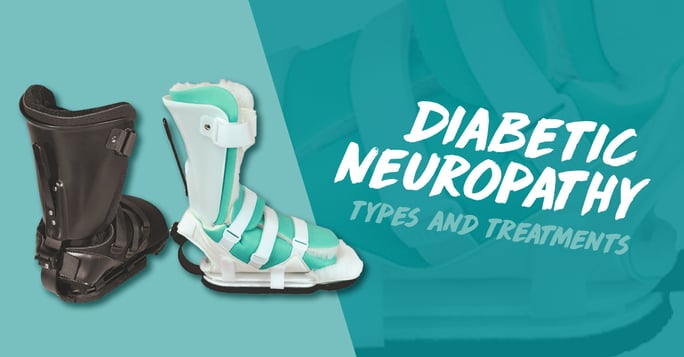
Diabetic neuropathy is painful. It can also be disabling – especially for those patients who are overweight or obese and already have mobility issues. While the condition often damages nerves in the legs and feet, it can be much more severe for the rest of the body.
Depending on the affected area, symptoms can range from pain and numbness in the lower extremities to digestive system problems, urinary tract issues, or blood vessel and heart problems.
There are four types of diabetic neuropathy and depending on the type and severity your patient is suffering from, treatment options can be different.
This blog will discuss the most common types of diabetic neuropathy and some treatment options.
Types of Polyneuropathy
Peripheral diabetic neuropathy, also known as peripheral diabetic nerve pain and distal polyneuropathy, is the most common form of neuropathy caused by diabetes. It affects nerves leading to the extremities - feet, legs, hands, and arms.
The nerves running to the feet are the longest nerves in the body. They branch off the spinal cord in the lower back and extend down the legs and into the feet. Because these nerves extend so far, they are often most easily damaged. This nerve damage leads to foot problems often associated with diabetes, including foot deformities, infections, ulcers, and eventually leading to, in some cases, amputations.
Proximal neuropathy is also called diabetic amyotrophy. ‘MYO’ means muscle, so this form of neuropathy can cause muscle weakness, specifically in the upper part of the legs, buttocks, and hips.
Sometimes, proximal neuropathy involves nerve pain, especially pain that extends from the low back and down the leg. The technical, medical term for that is radiculopathy, although most people refer to it as sciatica.
Proximal neuropathy is the second most common form of diabetic neuropathy and usually affects older adults with diabetes. It can sometimes resolve with time or treatment.
Autonomic neuropathy affects the autonomic nerves that keep the body running as it should. Bodily functions that occur without you thinking about them, like the heart pumping or breathing, are controlled by the autonomic nervous system.
If the autonomic nerves are damaged by diabetes, called autonomic diabetic neuropathy, the body may have trouble maintaining homeostasis.
Types of Mononeuropathy
The types of diabetic neuropathy listed above are examples of polyneuropathy, which affects many nerves. Focal neuropathy, by contrast, affects one specific nerve - it’s focused neuropathy. It is also called mononeuropathy.
Focal neuropathy typically comes on suddenly and most often affects nerves in the head. It can also affect the body and legs. When focal neuropathy affects the legs, it has different symptoms than proximal neuropathy. Focal neuropathy causes pain in particular locations on the legs.
Treatment options
Treatments for diabetic neuropathy are available and include several elements like diet and exercise, control of blood glucose levels, injury prevention, and management of painful symptoms.
We work with physicians and therapists to help determine the best treatment option for their bariatric patients.
The section below will highlight standard treatment considerations, including using ankle-foot orthoses as part of the program.
Prescription drugs
Like many ailments, prescription or over-the-counter medicines can help mask the pain associated with diabetic neuropathy. But relief is usually temporary and minimal.
Acetaminophen, aspirin, or ibuprofen can ease mild to moderate pain caused by diabetic nerve damage. But some of these drugs may increase the risk of heart attack, stroke, or kidney damage and should not be used for extended periods of time.
Controlling blood sugar
Your patients who don’t manage their diabetes will sometimes end up with blood glucose levels that are too high. Over time, that excess blood sugar can damage their peripheral nerves.
According to National Institute of Diabetes and Digestive and Kidney Diseases data, encouraging patients to keep their blood sugar in a healthy range (a hemoglobin A1C reading of 7% or lower) will help reduce their risk of nerve damage by 60 percent.
Increasing Vitamin D
Vitamin D, produced by the skin in response to sunlight, protects against nerve pain. However, getting the recommended 600 to 800 IU of vitamin D from food alone is difficult so some patients may need supplements.
Some studies found that people with diabetic neuropathy who took a Vitamin D supplement once a week had fewer symptoms after just two months.
Exercising and increasing mobility
The pain from diabetic neuropathy is sometimes worse when sufferers are at rest. Increasing physical activity like walking, swimming, or other low-impact exercises can help even when it’s painful.
Swimming is particularly effective because the water supports muscles, bones, and joints during the activity. This is soothing, especially for overweight patients or those with diabetic nerve pain in their feet.
Wearing Ankle-foot orthoses (AFOs)
Sometimes, the pain and lack of mobility are difficult for patients suffering from diabetic neuropathy. One treatment option that helps with both effects is using AFO devices.
Custom foot orthotics improve ambulation by reducing hyper-pronation and stress on foot and leg muscles. This allows the patient to remain active and lessens the possibility of other diabetic complications like kidney disease or a stroke.
Anatomical Concepts Bariatric AFO Ankle Foot Orthosis is an AFO designed to .png?width=254&name=Bariatric-Main-Image-1%20(1).png) accommodate larger patients. It can be used on ambulatory and recumbent patients and offers the same functionality as the standard APU® (Adjustable Posterior Upright) Orthosis, utilizing the heavy-duty APU® joint.
accommodate larger patients. It can be used on ambulatory and recumbent patients and offers the same functionality as the standard APU® (Adjustable Posterior Upright) Orthosis, utilizing the heavy-duty APU® joint.
The APU® Articulating Ankle/Foot Orthosis option features an adjustable posterior upright design that provides the practitioner a more precise and simplified method of setting the ankle/foot complex in the sagittal plane + or – 30º.
The posterior approach requires controlling one vertical joint, which lessens the chances of mechanical failure and eliminates pressure to the medial/lateral aspects of the malleoli that can be attributed to two joint systems.
While diabetic neuropathy is difficult to manage for your patients, it can be especially problematic for larger patients. Using AFOs with other treatment options can help minimize pain, improve mobility, and protect feet from further injury.
 330-757-3569
330-757-3569





